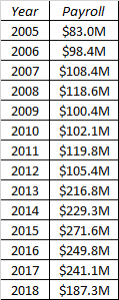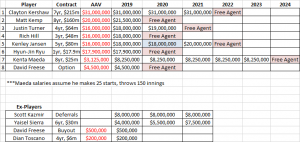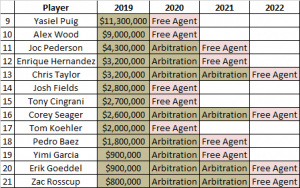MLBTR is publishing Offseason Outlooks for all 30 teams. Click here to read the other entries in this series.
The Cardinals had a thrilling season on the whole, but a tumultuous roller coaster ride bookended by significant winning and losing streaks ultimately ended on a low note as they missed the playoffs for the third consecutive season. That’s a lengthy drought by their standards, as fans hadn’t yet been forced to endure such a streak during the new millenium.
On the one hand, the club has a formidable crew under team control for 2019, including several franchise mainstays, and can expect a reasonable degree of improvement from its wealth of young talent. On the other hand, its veteran core includes eight players over 30 years of age (six are at least 32), and they could be facing some decline in production and/or injury risk from many members of that group. The club’s front office will surely be taking a slew of complex factors into account as they try to put together a contender for 2019.
Guaranteed Contracts
- Yadier Molina, C: $40MM through 2020
- Dexter Fowler, OF: $49.5MM through 2021
- Matt Carpenter, INF: $14.75MM through 2019, plus $2MM buyout on $18.5MM option for 2020
- Jedd Gyorko, INF: $13MM through 2019, plus $1MM buyout on $13MM option for 2020
- Carlos Martinez, SP: $34.5MM through 2021, plus $500K buyout on $17MM option for 2022
- Miles Mikolas, SP: $8MM through 2019
- Brett Cecil, RP: $15MM through 2020
- Kolten Wong, 2B: $16.75MM through 2020, plus $1MM buyout on $12.5MM option for 2021
- Luke Gregerson, RP: $5MM through 2019, plus $1MM buyout on $6MM vesting option for 2020
- Adam Wainwright, SP: $2MM through 2019
- Paul DeJong, SS: $22MM through 2023, plus $2MM buyout on $12.5MM option for 2024
Arbitration-Eligible Players (projections via MLBTR contributor Matt Swartz)
- Marcell Ozuna (5.124) – $13.4MM
- Michael Wacha (5.062) – $6.6MM
- Dominic Leone (3.123) – $1.3MM
- Chasen Shreve (3.167) – $1.2MM
Free Agents
[St. Louis Cardinals Depth Chart |St. Louis Cardinals Payroll Outlook]
Even after a relatively quiet trade deadline, the Cardinals surged to the forefront of the NL Central race with a torrid August that saw them go 22-6. But a mediocre 12-15 September cost them a chance to compete in the 2018 playoffs, proving that even the surprising midseason replacement of longtime manager Mike Matheny wasn’t enough to flip the club’s fate after a middling 47-46 start to the season. After three consecutive years of seeing their season end with game number 162, the perennially successful Cardinals organization could be facing a sense of urgency to right the ship and get back to October in order to satiate the fan base.
It’s difficult to tell where that process begins. While the team is loaded with fan favorites and high-caliber players in every area of the roster, they’re also staring down one or more significant question marks in their rotation, bullpen, outfield and infield. With their current construction, they’ve got an obviously good team. Unfortunately that’s not likely to cut the mustard in a division where they’re likely to face stiff competition from the Cubs and the now-soaring Brewers, both of whom have younger cores.
One of the simplest avenues would be to add several wins in one fell swoop, by paying for one of the market’s elite talents. The Cardinals have been connected to Bryce Harper this offseason, and have been speculated upon as a potential landing spot for Manny Machado as well. Either would fit easily into the club’s puzzle, and it wouldn’t be a surprise to see them spend big on a marquee free agent after being putting in strong bids for Jason Heyward and David Price in offseasons past. It’s also worth pointing out that they worked out a deal to acquire Giancarlo Stanton last season before the slugger used his no-trade clause to veto the move to St. Louis. While any realistic offer to add one of the market’s two biggest prizes would surely dwarf any of the three aforementioned contract sums, the Redbirds’ involvement serves as an indicator that adding a superstar bat lies within the realm of possibility.
But the market for both Harper and Machado comes with strong competition, so we can easily assume that the Cards are exploring several contingency plans. For example, the club will likely be motivated to make an upgrade at the hot corner if Machado lands elsewhere. Carpenter is aging and probably profiles best at first base at this point in his career, and Josh Donaldson might be a fitting target after previous reports of interest from St. Louis. Even Mike Moustakas could serve as an interesting add. It’s also worth noting that the Yankees could explore the market for Rookie of the Year runner-up Miguel Andujar in order to address their rotation, though it’s questionable whether the Cards would have any interest in giving up the type of young arm necessary to get a deal done. (Last night’s trade of James Paxton to the Yankees could also shift New York’s focus from the trade market to free agency for their remaining rotation needs.)
Turning an eye to the outfield, St. Louis may have in-house alternatives to signing Harper, should they lose out in that auction. Rookie Harrison Bader certainly earned a foothold on the center field job, and Ozuna is a lock to hold down left field. While Harper’s presence in right would make for a formidable outfield alignment, Fowler probably can’t be counted out as dead weight after a single horrendous season. Beyond him, the club has former top prospect Tyler O’Neill champing at the bit to follow up on a promising debut.
Absent from that list of in-house options is slugger Jose Martinez, who had an excellent offensive showing but proved to be an outright defensive liability. With that in mind, it seems unlikely he’ll be a part of their outfield plans come springtime (though the possibility shouldn’t be entirely dismissed, either), and his performance at first base even begs questions about whether his glove can be relied upon at all. Overall, the returns on playing him were positive; he yielded an above-average fWAR figure thanks to his excellent contact and on-base skills coupled with above-average power. But if the Cardinals wanted to get creative, they could look to explore shopping the slugger to American League team that might value him a bit more highly thanks to the ability to protect him from being entirely exposed defensively. There’d certainly be a number of suitors.
The bullpen is perhaps the Cardinals’ most glaring area of concern. A number of statistical shortcomings (including the second-highest walk rate of any ’pen in the game) led to a -4.54 WPA figure that would have stood as the worst in all of baseball save for the disastrous showing by a largely inexperienced Marlins relief corps. Norris, who held down the closer role for most of the season and was their bullpen’s most consistent fixture, is set to depart as a free agent. If they don’t re-sign him, they’ll probably find it necessary to find at least one viable alternative on the free agent market.
Make no mistake, that doesn’t necessarily mean they’ll be desperate to find anyone with closer experience. President of baseball ops John Mozeliak has said the Cardinals believe flamethrowing righty Jordan Hicks could succeed in that role (though as always that could simply be a negotiating technique), but that doesn’t mean he’ll actually have the job on opening day. The market is littered with former closers (e.g. Craig Kimbrel, Cody Allen, Kelvin Herrera), but it’s not difficult to imagine them instead rolling with Hicks and adding an upside lefty like Andrew Miller or Zach Britton. Speculation on specific names aside, it seems inevitable that the bullpen is an area to which they’ll allocate at least some money.
It’s worth noting that St. Louis will almost inevitably see some positive regression in relief performance, too. It’s more likely that Brett Cecil will rebound somewhat than that he’ll endure another career-low performance. Likewise, it’s improbable that the usually-durable Luke Gregerson will spend such an excessive amount of time on the DL. They won’t have Greg Holland walking nearly eight batters per nine innings across half a season’s worth of work, while Sam Tuivailala and Tyler Lyons represent other possible instances of addition by subtraction. Meanwhile John Brebbia, Dominic Leone and Dakota Hudson all had encouraging showings. In other words, while the Cardinals have some work to do in order to cover high-leverage innings, their situation isn’t quite as eyebrow-raising as a team like the Indians, for example.
Martinez, Wacha, Mikolas and rookie sensation Jack Flaherty seem like good bets to return to the rotation for 2019, while Alex Reyes, Luke Weaver and Adam Wainwright all in the mix for starts as well depending on health and performance. There’s room for improvement in their rotation, but it’s also not a bad cast overall; certainly other contenders are facing more daunting rotation questions. The situation gets murkier beyond 2019, though, as the contracts of Wacha, Mikolas and Wainwright all expire at season’s end. For that reason, we could see the Redbirds check in on free agents or trade targets whom they could keep in the fold for multiple seasons beyond the next. There’s no real urgency to do so, but there could easily be motivation given the right price and player.
The Cardinals are also an organization known for locking up many of their young players pre-arbitration, and this spring could present many opportunities to do just that. A wave of young players impressed last season, and the ever-opportunistic Cardinals brass could look to capitalize on the chance on some early extensions. Flaherty, Hicks, Bader and O’Neill could represent a strong core for years to come, and gaining additional control and cost-certainty over some of that group could allow the Cardinals to feel secure as some of their older veterans depart or retire in the near future.
Whatever path the Cardinals take this offseason, it seems unlikely to be a quiet one. With motivation to end an unusually long playoff drought, the organization will want to set new manager Mike Shildt up for success. They’ve got money to spend, a reasonable amount of prospect capital, and just enough positional flexibility on the roster to allow them to fit the right player into the picture if the opportunity arises. That should present a comfortable cavalcade of potential strategies to one simple end: add enough wins to remain competitive with a pair of formidable divisional opponents.



